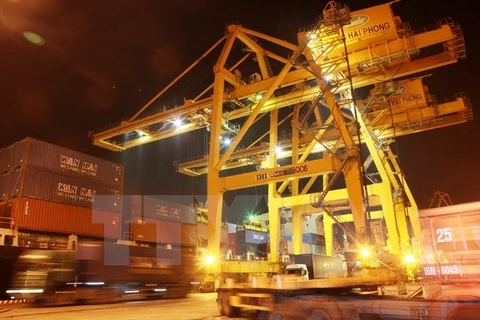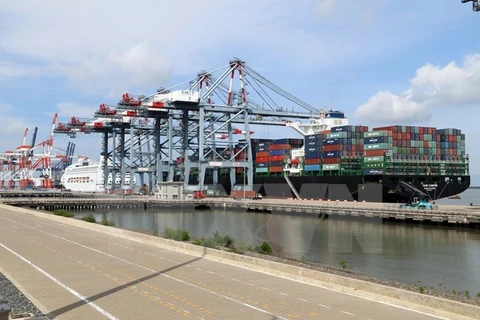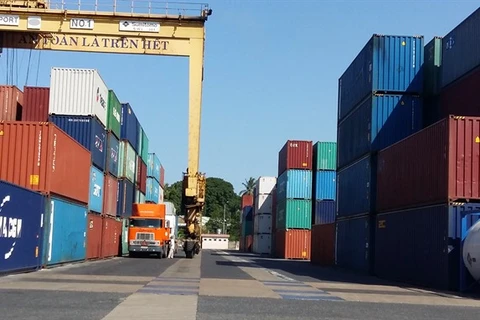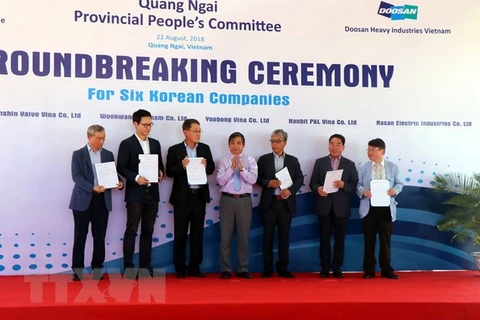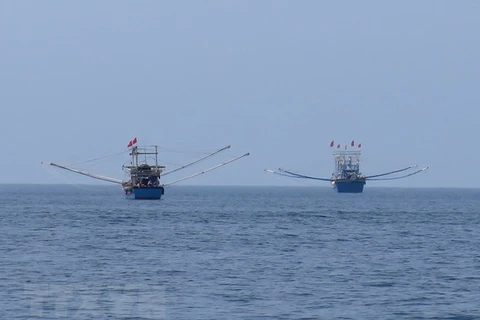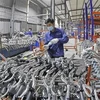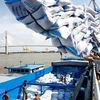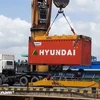 A worker loads a container onto a ship at the Tan Cang-Cao Lanh Port in Dong Thap Province. (Source: VNA)
A worker loads a container onto a ship at the Tan Cang-Cao Lanh Port in Dong Thap Province. (Source: VNA) HCM City (VNS/VNA) - River and sea ports in the Mekong Delta system of Group 6 ports handle a huge volume of goods, but 70 percent amount of goods in the region are still carried by road to Ho Chi Minh City.
About 85 million tonnes of goods are being loaded at ports in the region each year, according to Trinh The Cuong from the Vietnam Maritime Administration.
However, the seaports handle only 20-25 percent of the total cargo shipped by sea in the region, while the remaining is transported through ports in the southeastern region, he said.
The Ministry of Transport’s Planning and Investment Department blamed the problem on inefficiency and poor management of the existing ports.
Transportation of goods via Cai Cui, Hoang Dieu and Tra Noc ports in Can Tho city reached 2.11 million tonnes in 2015, 1.04 million tonnes last year, and 0.54 million tonnes in the first three months of this year.
Although the Government has designated ports in Can Tho city as the main shipping hub of the delta, their overall operations represented only 35 percent of the total capacity.
As of the end of 2016, Tan Cang-Cai Cui port was still focusing on container ships, and had not reached even 10 percent of its capacity.
The owner of a container shipping unit in Ho Chi Minh City said that one tonne of cargo transported from the Mekong Delta to Ho Chi Minh City ports via sea costs 10 USD, while transport costs by road are 11-16 USD.
However, door-to-door sea transport services are higher in costs compared to roads because of the cost of loading and unloading, which accounts for 35-40 percent of total costs. The transit time via sea is more than five times longer, he said.
“That is the reason shipping in the Mekong Delta is not attracting goods with high transport quality requirements,” he said.
Dao Anh Dung, Vice Chairman of the Can Tho City People’s Committee, said the Government has approved the city’s proposal to expand a logistics centre with a total area of 242.2ha at Cai Cui port in Hung Phu Industrial Zone 1B in Cai Rang district. "This logistics centre plan is expected to be approved this year,” he said.
Tran Tuan Hai, head of the Vietnam National Shipping Lines’ (Vinalines) Communication and Development Strategy Department, said Vinalines was working with the Phnom Penh Autonomous Port (PPAP) in Cambodia to set up a new container transport route from PPAP to ports in Can Tho to improve cargo capacity.
Coordinating with PetroVietnam Power Corporation (PV Power), Vinalines has also launched a container transport route from Cai Cui port to Singapore to transport coal to PV Power’s power plants, with output up to 7 million tonnes per year.
“This area also lacks dry ports and logistics centres to serve as transit points. Therefore, transport capacity is limited, and there are long waiting times and higher transport costs," he said.
Minister of Transport Nguyen Van The said that the Cai Cui port in Can Tho city should be built and act as a key logistics centre in the delta and an international trading and transshipment hub in the region.
He also assigned the Ministry of Transport’s Planning and Investment Department to coordinate with the Vietnam Maritime Administration to complete the overall planning of Tran De port in Soc Trang.
Preferential policies on charges and fees are also urgently needed to encourage container ships to carry goods directly to Mekong Delta ports.
Group 6 ports include river ports and seaports in 12 provinces and cities, including Cao Lanh-Sa Dec Port in Dong Thap province, My Tho port in Tien Giang province, Vinh Thai port in Vinh Long province, Ham Luong port in Ben Tre province and ports along the Tien River. These ports receive boats of 5,000 deadweight tonnes (DWT).
Seaports serving vessels of 10,000 to 20,000 DWT on the Hau River include Hoang Dieu, Cai Cui and Tra Noc ports in Can Tho city, My Thoi port in An Giang province, Dai Ngai port in Soc Trang province and Tra Cu port in Tra Vinh province and other specialised ports.
For ships of 5,000 to 10,000 DWT, seaports in the Ca Mau peninsula include Nam Can port in Ca Mau province, and Hon Chong, Bai No, Binh Tri and specialised ports in Kien Giang province’s western coast.
By 2020, the ports’combined capacity in the region is expected to transport 28 million tonnes of goods annually and 71.5 million tonnes by 2030.
Of the figure, cargo and container ships will account for 21-26 million tonnes of the total annual volume.-VNS/VNA
VNA
